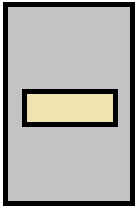Android_Resource/Activity的一些小知识点
setLayoutParams
textView.setLayoutParams(new TextSwitcher.LayoutParams(LayoutParams.FILL_PARENT, LayoutParams.FILL_PARENT));为什么要用TextSwitcher的LayoutParams呢。查一查API,可以看到这么一句话These supply parameters to theparent of this view specifying how it should be arranged。也就是说一定要用父控件的LayoutParams。如果父控件是LinearLayout,当然就必须写成LinearLayout.LayoutParams
FrameLayout的android:foreground属性可以设置单击时的前景色
触摸之后,设置前景色,可以告诉用户确实单击了,增加用户体验。
<FrameLayout android:foreground="@drawable/pressed_backgorund_corner" ><?xml version="1.0" encoding="utf-8"?> <selector xmlns:android="http://schemas.android.com/apk/res/android"> <item android:state_pressed="true"> <shape> <solid android:color="@color/defaultFocusAlphaColor"/> <corners android:radius="3dip" /> </shape> </item> <item android:drawable="@color/nocolor" /> </selector>这样,touch事件触发的时候,就会有前景色了。
findViewById之外的另一种获得控件的方法public View getChildAt(int index)
比如有这样一个布局文件
<?xml version="1.0" encoding="utf-8"?> <LinearLayout xmlns:android="http://schemas.android.com/apk/res/android" android:layout_width="fill_parent" android:layout_height="fill_parent" android:orientation="vertical" > <LinearLayout android:id="@+id/linearLayout" android:layout_width="fill_parent" android:layout_height="fill_parent" > <TextView android:layout_width="wrap_content" android:layout_height="wrap_content" /> <TextView android:layout_width="wrap_content" android:layout_height="wrap_content" /> </LinearLayout> </LinearLayout>我们没有为2个TextView设置ID,但是照样可以得到它们,方法如下LinearLayout linearLayout = (LinearLayout) findViewById(R.id.linearLayout); TextView tv1 = (TextView) linearLayout.getChildAt(0); TextView tv2 = (TextView) linearLayout.getChildAt(1);
关于子控件和父控件的事件响应问题
当父控件中有子控件的时候,并且父控件和子空间都有事件处理(比如单击事件)。这时,点击子控件,父控件的单击事件就无效了。如下图:

比如一个LinearLayout里面有一个子控件TextView,但是TextView的大小没有LinearLayout大
①如果LinearLayout和TextView都设置了单击事件,那么
- 点击TextView区域的时候,触发的是TextView的事件,
- 点击TextView以外的区域的时候,还是触发的LinearLayout的事件。
②如果LinearLayout设置了单击事件,而TextView没有设置单击事件的话,那么
- 不管单击的是TextView区域,还是TextView以外的区域,都是触发的LinearLayout的单击事件
如果LinearLayout的大小和TextView一样的话,那么
①如果LinearLayout和TextView都设置了单击事件,那么
- 只有TextView的单击事件有效
②如果LinearLayout设置了单击事件,而TextView没有设置单击事件的话,那么
- 触发的是LinearLayout的单击事件
XML文件中的@和?的区别
@大家已经司空见惯。比如@+id/... @string/...
?是什么呢,看下面代码:
<ProgressBar android:id="@+id/firstProgressBar" style="?android:progressBarStyleHorizontal" android:layout_width="200dp" android:layout_height="wrap_content" android:visibility="gone" />上面代码中用到了“?”,那么“?”是什么意思呢?“?”引用主题属性,当您使用这个标记,你所提供的资源名必须能够在主题属性中找到,因为资源工具认为这个资源属性是被期望得到的,您不需要明确的指出它的类型(也就是不需要写全在哪个文件中?android:attr/android:textDisabledColor)
那么什么又叫主题属性呢?
你可以在Android的SDK的以下目录中找到attrs.xml文件
D:\android-sdk\platforms\android-16\data\res\values
打开这个文件可以看到,Android系统的属性都定义在这个文件中。
举个例子(ImageView):
<declare-styleable name="ImageView"> <!-- Sets a drawable as the content of this ImageView. --> <attr name="src" format="reference|color" /> <!-- Controls how the image should be resized or moved to match the size of this ImageView. --> <attr name="scaleType"> <enum name="matrix" value="0" /> <enum name="fitXY" value="1" /> <enum name="fitStart" value="2" /> <enum name="fitCenter" value="3" /> <enum name="fitEnd" value="4" /> <enum name="center" value="5" /> <enum name="centerCrop" value="6" /> <enum name="centerInside" value="7" /> </attr> <!-- Set this to true if you want the ImageView to adjust its bounds to preserve the aspect ratio of its drawable. --> <attr name="adjustViewBounds" format="boolean" /> <!-- An optional argument to supply a maximum width for this view. See {see android.widget.ImageView#setMaxWidth} for details. --> <attr name="maxWidth" format="dimension" /> <!-- An optional argument to supply a maximum height for this view. See {see android.widget.ImageView#setMaxHeight} for details. --> <attr name="maxHeight" format="dimension" /> <!-- Set a tinting color for the image --> <attr name="tint" format="color" /> <!-- If true, the image view will be baseline aligned with based on its bottom edge --> <attr name="baselineAlignBottom" format="boolean" /> <!-- If true, the image will be cropped to fit within its padding --> <attr name="cropToPadding" format="boolean" /> </declare-styleable>以上是从attrs.xml文件中提取的,可以看到ImageView的一些特有属性(由于ImageView继承自View,所以View的属性自然就继承了)。同样,Android系统也为Theme定义了很多属性(可以看看attrs.xml文件),其中每个主题属性的名称都一一对应D:\android-sdk\platforms\android-16\data\res\values目录下的themes.xml文件。当要用到主题属性的时候,就不需要特别指定android:attr/,可以直接在?后面加上属性名。
资源文件夹res/raw和asserts的异同
相同点:两个目录下的文件在打包后都会原封不动的保存到apk中,不会被编译成二进制。
不同点:
- res/raw中的文件会被映射到R.java中,访问的时候直接使用资源ID即R.id.filename;assets文件夹下的文件不会被映射到R.java中,访问的时候需要AssetManager类
- res/raw不可以有目录结构,而assets则可以有目录结构,也就是assets目录下可以再建立文件夹
读取res/raw下的资源代码:
InputStream is = getResources().openRawResource(R.id.filename);
读取asserts下的资源代码:
AssetManager am = getAssets();
InputStream is = am.open("filename");
另外:res/raw和assets文件大小都有限制(有些资料说高版本的Android系统取消了这种限制),默认最大仅支持1M的文件,否则apk程序将报错。如果AssetManager或Resources classes方法来获取InputStream,将抛出java.io.IOException的异常如下DEBUG/asset(1123): Data exceeds UNCOMPRESS_DATA_MAX。